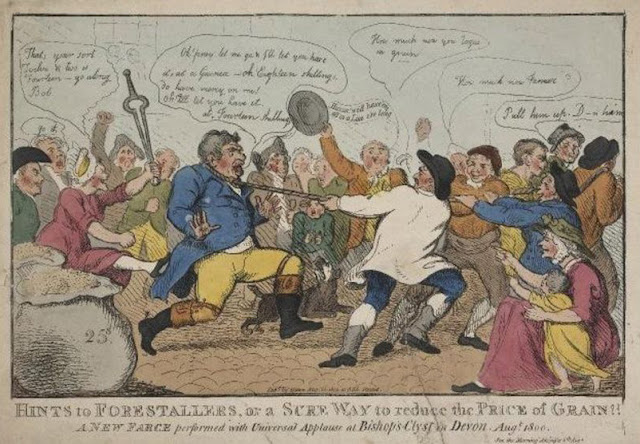Between 1799 and 1801 food riots, brought on by scarcity and high prices which in turn had been caused by poor harvests and the effects of Napoleon’s continental blockade, regularly broke out throughout England. With imports being limited, grain was at a premium which increased the price of bread, the cost of a loaf jumping to an all time high of 1s.9d, while other foods such as butter and cheese saw similar hefty hikes in price, a situation not helped by greedy profiteers inflating prices further still. As many of the poor working classes lived off a diet in which bread and other basics played a major part, any serious increase in their prices was bound to cause problems and spark often violent protests. London, Birmingham, Oxford, Nottingham, Coventry, Norwich, Stamford, Portsmouth, Sheffield and Worcester, amongst other places all saw bouts of rioting at this time and the Potteries too suffered several outbreaks.
 |
| A satirical cartoon depicting a fat 'forestaller' being dragged along by a rope round his neck by a chain of countrymen, to the cheers of a crowd. Illustration by Isaac Cruikshank |
On Monday 28 April 1800, a serious food riot broke out after a mob assembled at Lane End and seized a quantity of potatoes, flour and other goods, which they quickly shared out among themselves. The rioting became so serious and alarming that the local Volunteers were called out and the Riot Act was read, though to little effect. So the authorities had to get tough and the Volunteers were sent to capture the ringleaders and after a scuffle seven people were dragged off to Stafford gaol guarded by a party of the Newcastle and Pottery troop of Cavalry. They were William Hatton, William Doukin (or Dowkin), William Myatt, Solomon Harding, Emma Vernon, Ann Goodwin and Sarah Hobson, all of whom were subsequently sent for trial at the Stafford Assize in August. Most were acquitted, but 29 year old Emma Vernon also known as Emma Berks or Amy Burke, who was identified as the chief troublemaker, was found guilty of riotous assembly 'with other persons above the number twelve, and continuing together for one hour after Proclaimation'.
At the time rioting was a capital offence and Emma was initially sentenced to be hanged on 30 August at Stafford, but on 13 August her sentence was commuted to one of transportation for 21 years to Australia. In June 1801, Emma Berks (alias Emma Vernon, Amy Burke) was one of 297 prisoners transported aboard the curiously named ship Nile, Canada and Minorca, which arrived in New South Wales on 14 December 1801. She would never return, dying in Australia on 1 July 1818, aged 47.
The April riot, though, was not the last to plague the area and in late September more trouble broke out. The Staffordshire Advertiser, whilst praising the exemplary fortitude of the locals during the ongoing food crisis, was dismayed to report 'that since Monday last [22 September] a disposition to riot has manifested itself in various parts of the Potteries.' Miners and potters were reported to have assembled in large groups and going to local food shops had seized provisions and sold them on at what they considered fairer prices. A troop of the 17th Light Dragoons quartered at Lane End, the Trentham, Pottery and Stone Troops of Yeomanry Cavalry, plus the Newcastle and Pottery Volunteers had been repeatedly called out to deal with these infractions and thus far had managed to keep a lid on the situation, curbing any dangerous acts by the mobs. Indeed, the only overtly violent act that the Advertiser could report was that one boy had been seized for hurling stones and was taken into custody. More pleasingly it was noted that some the inhabitants of Hanley and Shelton in an effort to stamp out the blatant profiteering at the root of the troubles, had made a collective resolution not to buy butter from anyone selling at more than 1 shilling per lb and various communities around the Potteries were following suit. Prior to this butter had been shamefully priced at 16d or 17d per lb. The Marquis of Stafford also stepped in and ordered his tenants to thresh their wheat and take it to market, which many did, selling it at the reasonable price of 12s per strike [i.e. 2 bushels]. The paper lauded such actions and hoped that it would promote further reductions in prices. Certainly it quelled the growing unrest in the area and by the the next edition of the paper the Potteries had returned to 'a state of perfect tranquillity', with 'the pleasing prospect of the necessaries of life being much reduced in price.'
(Staffordshire Advertiser, 3 May 1800, p.4; 23 August 1800, p.4; 30 August 1800, p.4; 27 September 1800, p.4; 4 October 1800, p.4)